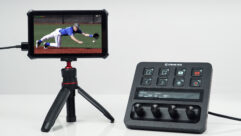
Become the Director
Feb 17, 2010 12:00 PM,
By Don Kreski
Tips on making a great online video.

Creating online video is a smart move that can garner a great deal of interest in your business and potentially land you installation jobs.
Here’s a demonstration of the power of online video: Try searching for “Sanyo camcorder” first on Amazon.com and then on YouTube.
On Amazon, click on almost any Sanyo camcorder model (try the Xacti VPC-E2), and you’ll find a section with one or more clever videos produced by Sanyo. Now try the search on YouTube. The same clips are there, but they’re buried under a mountain of amateur videos created by Sanyo customers. It’s a great example of viral marketing: Their customers have taken on the job of demonstrating Sanyo’s camcorders.
Wondering what AV professionals might learn from this example, I recently spoke to Sam Malik, director of sales and marketing for Sanyo Presentation Technologies, and Jim Noyd, the divison’s PR agency person who has done several video projects for them recently. Malik says he sees a great opportunity for AV integrators to post videos about their installations.
“There are a lot of fantastic installs out there,” Malik says. “When you can say, ‘Here’s something that we put together and here’s how it’s used,’ it makes a much more believable case than a scripted piece saying, ‘Here’s our product, and here’s what it’s capable of.'” While he concedes that shooting a video about a waterproof camcorder is probably more fun than creating one about a projector install, he argues that there’s a great deal of interest in installed systems and a hunger to learn more about them.
I thought it might be helpful to outline the process that Sanyo uses to produce its videos and include suggestions that Malik and Noyd have for integrators thinking about creating their own.
The professional approach
First, Malik says, “It’s really important to understand the attention span of the viewer. And if we’re talking about people looking at videos on the Internet, that’s not very long.”
How long is too long? “People are not going to watch a 12-minute video unless it’s very technical, and then your audience starts to get very narrow,” he says. Consider producing a few 3-minute videos rather than one long one. “You should also think in terms of presenting one or two key ideas in each video—no more than three,” Noyd says.
Writing the script for any professional video is the most difficult and time-consuming part, Noyd says. For each of Sanyo’s short online videos, Malik’s staff and agency people will typically spend about two weeks in scriptwriting; a week or so in other preproduction work, such as lining up talent, creating a set, and gathering product; one day shooting; and two more weeks in editing and postproduction. “It’s very important that you get everyone’s buy-in before you go to the studio,” Noyd says.
The day an agency crew goes in to shoot, Noyd says they have everything planned as closely as possible—not just what will be included in the video, but when it will be shot and how. “If you have talent involved, you really want them to have that script well in advance, so when they show up for the shoot, they are comfortable with the material and have practiced it,” he says.
Often the actor or actress will have questions about the script, and as an outsider, they may have worthwhile suggestions about parts that don’t sound good or are hard to understand. For that reason, Noyd likes to have the writer at the shoot. The writer is able to instantly massage anything that needs work. Noyd also likes having representatives from Sanyo marketing and engineering on hand to make sure any changes make sense and are on target with the company’s overall message.
That’s especially important because, most often, the producers will find ways to tighten up the script as the shooting progresses. “We try to do a couple of run-throughs of the entire script, and then we go back to tighten every section of every paragraph,” Noyd says. “Usually it’s only after the second or third take that the production really starts to make sense to everyone. At that point, we’ve got the action down, and we know what we want the talent to do with their hands. We’ve figured out how to make the product do what it needs to do. And because we’re shooting all along, we also know we’re covered if we decide later that we like the longer explanation more than the short one.”
At the end of the day, Noyd says, they go back through everything they did, making notes with all of the stakeholders about what they did and did not like. “We also ask, ‘Are there pickups we’re going to need to make from an audio standpoint? Are there visuals we’re going to need to create in postproduction? And who is responsible for getting those assets to the production company?'”
Become the Director
Feb 17, 2010 12:00 PM,
By Don Kreski
Tips on making a great online video.
If you create your own
Malik says that Sanyo is probably more careful about production values than a Sanyo dealer might need to be. “For a company like ours, we just can’t go out and shoot some raw footage and then post it on the ‘net. It’s just not going to reflect the kind of image we’re trying to create. But there are a lot of folks out there who can produce good inhouse video, possibly edit it themselves, and get it online to help them promote their businesses,” Malik says.
If you want to shoot your own video or use a low-cost local producer, he says there are several important things to keep in mind:
Related Links

As important as electronic media have become to most companies, there’s still a lot of value in a printed brochure…

Shooting Your Own Installation Photos
How can you take and submit photos of your work to ensure they will be considered for coverage in print magazines? …

Including Video on Your Website
The popularity of YouTube has been a bit of a shock to many videographers, who have worked hard throughout their careers to uphold the highest production values…
Be sure to shoot plenty of footage. Both Malik and Noyd agree that you’ll need to shoot at least five times as much video as you’re actually going to use. “Once you take it into editing,” Malik says, “you’re just using snippets and clips. It’s amazing how much you end up throwing away.”
Good lighting is crucial, as is good sound. Pay attention to what’s going on outside of the main part of the image. “You need to make sure you don’t have any crazy shadows, that you can see everything clearly, and that there’s nothing distracting in the background,” Malik says. “When you finally get the video posted on the Net, these things are really important.”
Be sure to shoot in high definition. “Even YouTube is showing 1080p now,” he says. “It’s got to be digital, and it’s got to be high resolution.”
Be sure there’s a clear call to action and that your contact information is prominent both within the video and on the webpage where it’s posted.
Consider using professional talent, but look around within your own organization for people who might do well on camera. “Almost every AV integrator has one or two sales people who are really well-spoken and really good at explaining concepts to customers,” Noyd says. These people not only can be great on camera, but they can be a big help in suggesting concepts for a video and the points you need to get across to potential customers.
Ultimately, your video will succeed or fail based on the usefulness of the information you present. “Because people are searching for specific information online,” Malik says, “they definitely have the potential to become repeat customers or at least repeat prospects. If your video is helpful, if it is reliable, if it answered their questions and gave them the information they needed, they will come back again and again and send your video to other people. And that can do a lot to drive your business forward.”
Don Kreski is the president of Kreski Marketing Consultants, which offers marketing services to the AV industry. You can reach him at www.kreski.com/contact.html.










